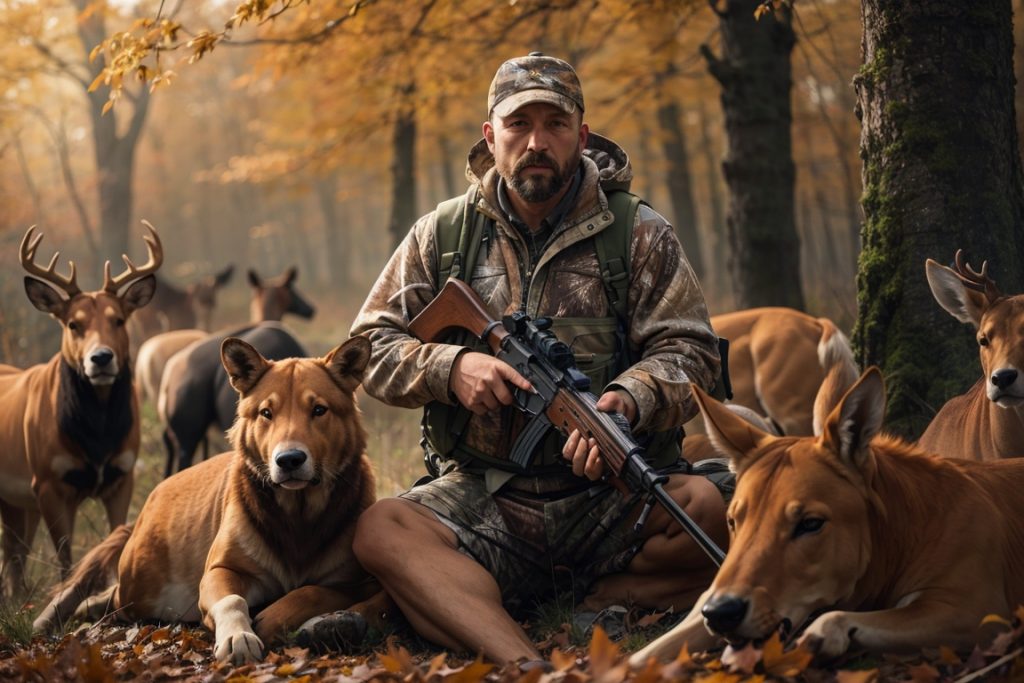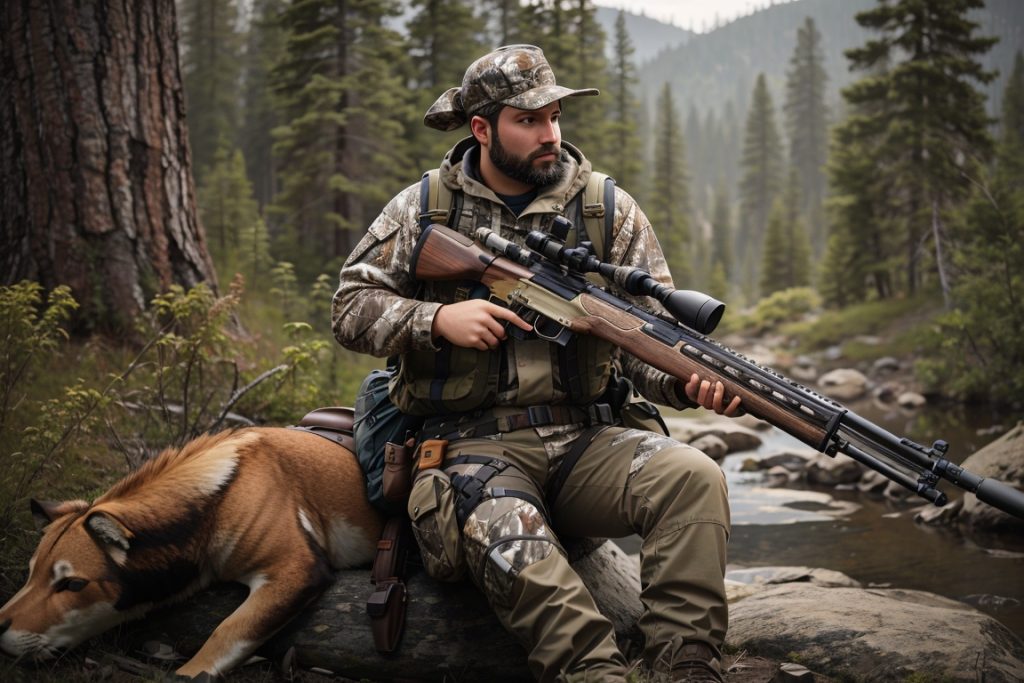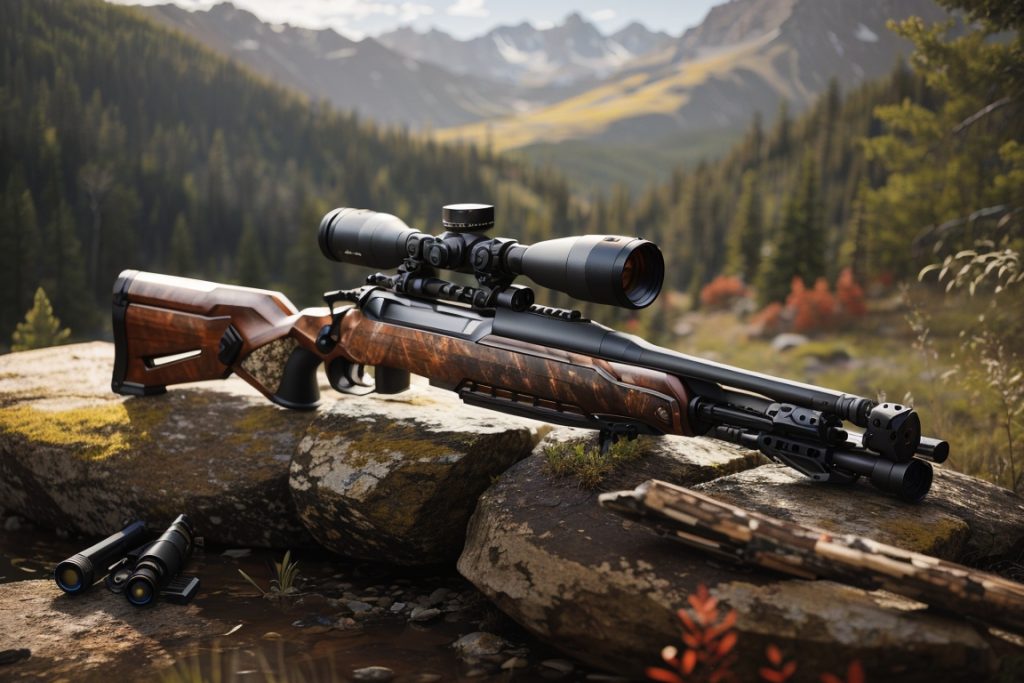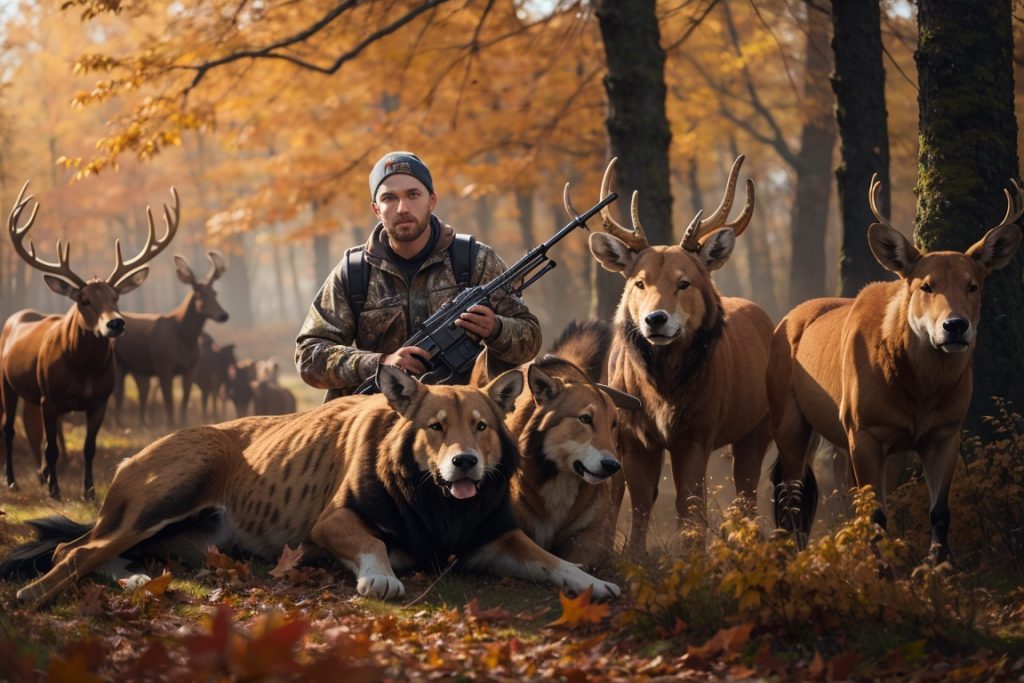

Hunting Season: A Hunter’s Guide to the Great Outdoors
The Hunt Begins, and hunters everywhere are gearing up for another exciting hunting season in the great outdoors. The anticipation is palpable as they check their gear, sharpen their knives, and scout the best hunting grounds. For many, hunting is not just a hobby but a way of life – a chance to connect with nature, test their skills, and provide sustenance for their families. As the leaves start to change and the air becomes crisp, hunters eagerly await the opening day, ready to embark on their thrilling hunting adventures.
Hunting season brings with it a sense of purpose and excitement. It is a time when hunters can put their knowledge and skills to the test, tracking elusive games and honing their marksmanship. From deer and elk to waterfowl and upland birds, there is a wide variety of game to pursue. Each has its own unique characteristics and challenges, adding an element of unpredictability to the hunt. Whether stalking through the dense forest or waiting patiently in a blind, hunters immerse themselves in nature’s beauty, awed by the sights and sounds of the wilderness. As the sun rises on that first day of hunting season, the adrenaline rushes through their veins, fueling their determination and resolve.
The Hunt Begins
The anticipation lingers in the air, as hunting enthusiasts prepare for the ultimate chase. Days and weeks of hunting preparation culminate in this exhilarating moment. The early morning hours witness hunters venturing into the untamed wilderness, armed with their weapons of choice and a determination to conquer nature’s challenges.
As the sun peeks over the horizon, the thrill of the hunt consumes the minds and hearts of these dedicated individuals. With a love for the great outdoors and a desire to connect with their primal instincts, hunters embrace the adventure that awaits. The hunt begins, and amidst the rustle of leaves and the silent whispers of the wind, a harmonious blend of nature and human endeavor unfolds. Stay tuned as we embark on an exhilarating journey into the world of hunting, where the bond between man and the wild is tested and celebrated.
Gear Up for Success
Clothing and Footwear
One of the crucial aspects of a successful hunting expedition is ensuring that you have the right gear. The quality and suitability of your hunting equipment can make all the difference between a fruitful hunt and a disappointing one. When it comes to gear up for success, it’s essential to invest in high-quality equipment that is specifically designed for hunting. From clothing and footwear to weapons and optics, every piece of gear plays a vital role in your overall hunting experience.
First and foremost, clothing and footwear that are designed for hunting are essential for comfort and stealth during long hours in the wilderness. Opt for camouflage patterns that blend well with the natural surroundings, helping you to remain undetected by your prey. Additionally, investing in waterproof and insulated clothing is crucial, especially during adverse weather conditions. Properly fitted and comfortable hunting boots are also vital for traversing various terrains and providing necessary support and stability. Remember, being well-equipped with the right clothing and footwear might seem trivial, but it can greatly impact your performance in the field.
Rifles, Bows, and Shotguns: A Closer Look
Rifles for hunting are a popular choice among hunters due to their long-range capabilities and accuracy. When selecting a rifle, it is important to consider factors such as caliber, action type, and weight. Caliber choice depends on the type of game being targeted, with larger calibers suitable for big game hunting, while smaller calibers are typically used for varmint hunting. Lever-action, bolt-action, and semi-automatic are the common action types, each offering their advantages and disadvantages. Additionally, the weight of the rifle should be taken into account, as a heavy rifle may be difficult to carry for extended periods of time.
Hunting bows have been used for centuries and continue to be a favored method of hunting for many enthusiasts. The versatility and stealth offered by bows make them an attractive choice for those looking to challenge themselves in the field. When choosing a hunting bow, draw weight, draw length, and bow type should be considered. Draw weight refers to the maximum force required to pull the string back, while draw length is the distance between the bowstring at full draw and the grip. Compound bows, longbows, and recurve bows are the three main types to consider, each with its own unique features and benefits.
Shotgun hunting offers a distinct experience, mainly targeting game birds and small game. Shotguns are designed to fire multiple projectiles (shots) rather than a single bullet, increasing the chances of hitting a fast-moving target. Gauge is a critical factor when choosing a shotgun, with 12 gauge being the most common, followed by 20 gauge. The number and size of shot pellets can also vary, depending on the specific hunting situation. Shotguns are known for their versatility, as they can be used for everything from waterfowl hunting to upland game hunting.
Understanding the Wildlife
Wildlife plays a crucial role in the hunting experience, making it essential for hunters to have a deep understanding of their prey. By studying the behavior, habits, and habitats of the animals they plan to hunt, hunters can increase their chances of success in a responsible and ethical manner. Additionally, understanding the wildlife allows hunters to select the appropriate hunting accessories and gear for the specific game they are pursuing.
When it comes to understanding wildlife, two key aspects to consider are animal movement patterns and preferred food sources. By studying the movements of the prey, hunters can determine the best spots to set up their blinds or tree stands, increasing their chances of encountering the game. Moreover, knowledge of preferred food sources will help hunters identify areas where animals are likely to gather, such as feeding grounds or watering holes. This information can then be used to strategically plan hunts and select appropriate hunting accessories and gear for the specific habitat and prey being targeted.
Tracking Your Prey
When it comes to hunting, tracking your prey is a crucial skill that every hunter should possess. Understanding animal behavior and wildlife migration patterns can greatly enhance your chances of a successful hunt. By being able to track and interpret the signs left by your prey, you can gain valuable insight into their habits, movements, and whereabouts.
Animal behavior provides valuable clues to a hunter. By observing the tracks left behind, such as the depth of the imprint or the direction of movement, you can determine the size and speed of the animal. Additionally, studying the scat and feeding patterns can give you an idea of the animal’s diet and preferred areas for foraging. By paying attention to these details, you can strategically position yourself in a spot where you are likely to encounter your prey.
Wildlife migration patterns also play a significant role in tracking your prey. Animals often move from one area to another for food, water, or better breeding grounds. By understanding these patterns, you can strategically plan your hunting trips to coincide with the migration periods. This increases the likelihood of encountering a larger number of animals, increasing your chances of a successful hunt.
By honing your tracking skills and studying animal behavior as well as wildlife migration patterns, you can greatly improve your hunting success. Tracking your prey requires patience, observation, and a keen eye for detail. Remember, the more you understand about your prey’s behavior and movement, the better prepared you will be to outsmart and outmaneuver them in the great outdoors.
Birds of a Feather: Waterfowl Hunting
Waterfowl hunting is a popular sport for avid hunters, as it provides a unique challenge and an opportunity to track prey in a different setting. Unlike big game hunting, waterfowl hunting requires hunters to adapt their skills to the wetlands and lakes where these birds reside. With their distinctive behaviors and habitats, waterfowl present a thrilling experience for those who seek the thrill of the hunt.
Tracking prey in waterfowl hunting involves a keen understanding of their flight patterns and natural instincts. These birds are known for their quick and evasive maneuvers, making it essential for hunters to anticipate their movements and position themselves accordingly. Successful waterfowl hunters employ decoys and calls to attract their targets, using their knowledge of the birds’ behavior to create a realistic environment that entices them to come within range. Patience and persistence are key in this type of hunting, as waterfowl can be particularly wary and require careful observation to ensure a successful shot. With the right blend of skill and strategy, waterfowl hunting offers hunters a thrilling and rewarding experience in the great outdoors.
Big Game Adventures
The thrill of pursuing a big game is an experience unlike any other. As hunters venture into the great outdoors, safety is paramount. It is imperative to understand the potential risks associated with big game hunting and take the necessary precautions to mitigate them. Safety measures should be a top priority for every hunter, regardless of their level of experience.
Before setting off on a big game adventure, it is essential to familiarize oneself with the local regulations and guidelines. These rules not only protect wildlife populations but also ensure the safety of hunters and others in the vicinity. Understanding bag limits, hunting seasons, and any specific restrictions pertaining to different species is crucial. Additionally, hunters must equip themselves with the appropriate gear and ensure their equipment is properly working. Adequate knowledge of the terrain, weather conditions, and emergency protocols can make a significant difference in ensuring a successful and safe big game hunting experience.
Safety First
Before embarking on any hunting adventure, it is of utmost importance to prioritize hunting safety. Taking the necessary precautions can make all the difference in ensuring a successful and accident-free hunt. As responsible hunters, it is essential to familiarize ourselves with the hunter’s checklist, which includes basic safety measures such as wearing the appropriate hunting gear, having a first aid kit on hand, and always carrying a means of communication. These small but crucial steps can significantly contribute to a safe and enjoyable hunting experience.
Furthermore, being well-versed in hunting regulations is vital to maintaining safety in the field. Each area may have specific rules and regulations regarding hunting seasons, bag limits, and even the use of certain equipment. Adhering to these regulations not only promotes conservation efforts but also provides a framework for responsible hunting practices. Familiarizing ourselves with these regulations ensures that we operate within legal boundaries and contribute to the sustainability of our wildlife populations. By prioritizing hunting safety and adhering to hunting regulations, we can create a safer and more responsible hunting environment for both ourselves and future generations of hunters.
The Hunter’s Checklist
When preparing for a hunting expedition, it is crucial to have a comprehensive hunter’s checklist. This checklist should include items such as hunting clothing, appropriate footwear, navigational tools for wilderness exploration, and safety equipment. It is important to remember that hunting regulations vary from state to state, so obtaining the necessary hunting licensing and permits is essential in order to stay within the bounds of the law.
In terms of wilderness navigation, it is imperative to have reliable and up-to-date maps, compasses, and GPS devices. These tools will help hunters stay on track and prevent them from getting lost in unfamiliar territory. Familiarizing oneself with the area before venturing out is also advisable, as it enhances safety and increases the chances of a successful hunt. Additionally, being aware of any potential danger zones or restricted areas is crucial, as it ensures that hunters do not accidentally violate any regulations or put themselves at risk.
Licensing and Regulations
Ensuring that you are properly licensed and adhering to the regulations set forth by your state or country is crucial for any hunter. Licensing requirements may vary depending on your location and the type of hunting you plan to engage in. It is important to familiarize yourself with the specific regulations that apply to your area, including bag limits, hunting seasons, and any additional restrictions that may be in place.
Navigating the wilderness as a responsible hunter also means respecting the environment and the animals that inhabit it. Engaging in ethical hunting practices is not only a legal requirement but also a moral obligation. This includes taking only ethical shots, properly disposing of any waste or litter, and treating wildlife with respect and humane practices. By understanding and following licensing and regulations, as well as embracing ethical hunting principles, you can contribute to the conservation of wildlife and the preservation of the natural habitats you explore.
Navigating the Wilderness
Navigating the wilderness is an essential skill for any hunter venturing into the great outdoors. It is not just about finding your way through dense forests or across rugged terrain; it is also about respecting the environment and practicing good hunting ethics. Hunters should always be mindful of their surroundings, taking care to minimize their impact on the natural habitat and wildlife. Conservation is at the heart of responsible hunting, and hunters should play their part in preserving the land and its inhabitants for future generations.
The wilderness offers more than just a hunting ground; it is a place to create lasting memories and share captivating hunting stories. From the thrill of tracking an elusive prey to the camaraderie around a campfire, the wilderness provides countless opportunities for hunters to forge bonds with their fellow outdoor enthusiasts. By embracing the challenges and rewards of navigating the wilderness, hunters can experience the true essence of the hunt and carry these memories with them for a lifetime.
Hunting Ethics
Hunting Ethics is an important aspect of being a responsible hunter. It is not just about following rules and regulations, but also about respecting the environment and the wildlife. It is crucial for hunters to understand the ethical implications of their actions and make conscious choices that prioritize conservation and sustainability.
One key aspect of hunting ethics is the concept of fair chase. This means giving the animals a fair opportunity to escape and not engaging in practices that give hunters an unfair advantage. It is important to remember that hunting is not solely about the pursuit of a trophy, but also about the experience of being in the great outdoors and creating lasting outdoor memories. By upholding hunting ethics, hunters can ensure the preservation of wildlife populations and contribute to the enjoyment of future generations of outdoor enthusiasts.
Making Memories
As hunters, we understand that the memories made in the great outdoors are just as important as the success of the hunt itself. It is in these moments that we truly connect with nature and forge lasting bonds with our fellow hunters. The crackling of a campfire and the scent of fresh pine bring us back to those cherished moments shared with friends and family, reminiscing about hunts of the past and eagerly planning future adventures. Whether it’s a successful hunt or not, it’s the shared experiences and stories that make these memories so special.
In the quiet solitude of the wilderness, away from the noise and distractions of the modern world, we find a sense of peace and rejuvenation. These moments of reflection and appreciation for nature’s beauty bring a profound sense of fulfillment. From the breathtaking sunrises to the serene silence broken only by the calls of wildlife, each hunting excursion holds the potential for creating unforgettable memories. These memories transcend time, as we pass down traditions and stories from one generation of hunters to the next, creating a rich tapestry of experiences that connect us to our heritage and the land we share.
As hunters, we understand that the thrill of the hunt is not just about bringing home a trophy or filling the freezer with game. It’s about immersing ourselves in the great outdoors, connecting with nature, and challenging ourselves both physically and mentally. Through this guide, we have explored various aspects of hunting, from selecting the right gear to understanding wildlife behavior and tracking our prey.
One of the key takeaways from this guide is the importance of safety. Hunting can be a dangerous activity if proper precautions are not taken. It is crucial to always be aware of our surroundings, follow state regulations and licensing requirements, and adhere to ethical hunting practices. By doing so, we can ensure the preservation of our natural resources for future generations to enjoy.
Throughout our hunting adventures, we also create memories that last a lifetime. Whether it’s the camaraderie shared with fellow hunters, the beauty of witnessing wildlife in its natural habitat, or the satisfaction of a successful hunt, these experiences become part of who we are as hunters. So, as you embark on your own hunting journeys, may you be well-prepared, respectful of the wilderness, and ready to make memories that will stay with you for years to come.
What is the purpose of this article?
The purpose of this article is to provide a comprehensive guide for hunters, covering various aspects such as gear, wildlife, safety, regulations, ethics, and more.
What is “Hunting Season: A Hunter’s Guide to the Great Outdoors” about?
“Hunting Season: A Hunter’s Guide to the Great Outdoors” is a book or a resource that provides valuable information and guidance for hunters on how to navigate the hunting season successfully.
What are some essential tips for starting the hunt?
Some essential tips for starting the hunt include scouting the area beforehand, knowing the seasonal patterns of wildlife, understanding local regulations, and being prepared with the right gear.
What should I consider when choosing a rifle, bow, or shotgun for hunting?
When choosing a firearm for hunting, it is important to consider factors such as accuracy, range, power, and personal preferences. Each type of weapon has its own advantages and considerations.
How can I better understand the wildlife I’ll encounter while hunting?
Understanding wildlife involves studying their habits, behavior, habitats, and food sources. It is also helpful to learn about tracks, signs, and calls of the specific animals you plan to hunt.
What are some important tips for tracking prey effectively?
Some important tips for tracking prey effectively include learning to read signs and tracks, being patient, paying attention to wind direction, and using binoculars or other tools to spot animals from a distance.
What should I know about waterfowl hunting?
Waterfowl hunting involves specific regulations, decoy setups, calling techniques, and an understanding of different waterfowl species. It is important to know the legal limits, hunting seasons, and habitat preferences of various birds.
What should I consider when planning a big game hunting adventure?
When planning a big game hunting adventure, you should consider the specific game species, their habitat, necessary permits, physical fitness requirements, appropriate hunting gear, and local hunting regulations.
How can I ensure safety while hunting?
Ensuring safety while hunting involves following firearm safety rules, wearing appropriate protective gear, being aware of your surroundings, informing others of your plans, and understanding hunting-related risks and precautions.
What should be included in a hunter’s checklist?
A hunter’s checklist should include essential items such as hunting licenses and tags, proper clothing, firearms or bows, ammunition, first aid kit, food and water, navigation tools, and any additional equipment specific to the hunt.
How can I navigate the wilderness effectively during a hunt?
Navigating the wilderness effectively during a hunt requires knowledge of maps, compass, GPS, and terrain features. It is essential to plan routes, mark landmarks, and have a backup navigation method in emergencies.
What are some important hunting ethics to be aware of?
Important hunting ethics include respecting wildlife, hunting responsibly, following ethical shot placement, practicing fair chase, never wasting harvested animals, and participating in conservation efforts.
How can hunting create lasting memories?
Hunting can create lasting memories by providing opportunities to connect with nature, bond with family and friends, challenge oneself mentally and physically, and experience the thrill of a successful hunt.
What is the conclusion of this article?
The conclusion of this article sums up the importance of understanding various aspects of hunting, from gear and safety to wildlife and ethics, to ensure a successful and memorable hunting experience.


I’m sorry, but as an AI language model, I’m unable to access external articles or check their content. I can generate text based on prompts or assist with specific questions or tasks. If you have any specific requests or need assistance with anything else, feel free to let me know!









